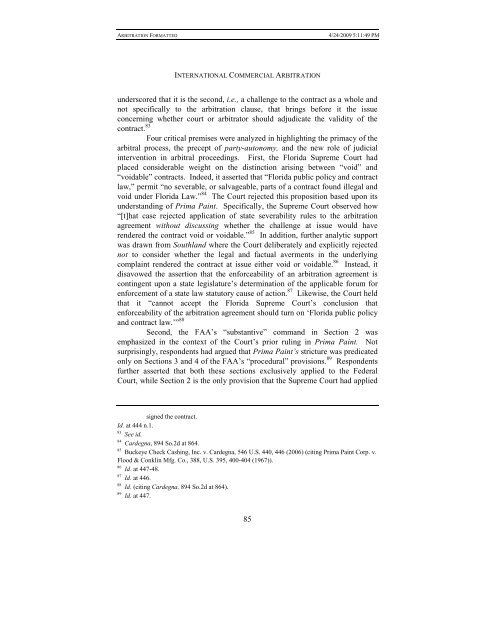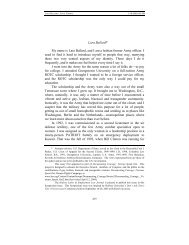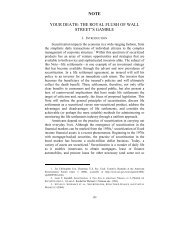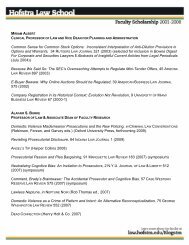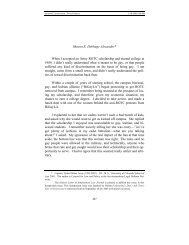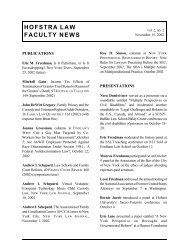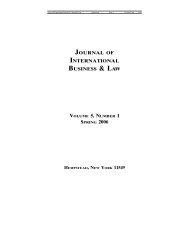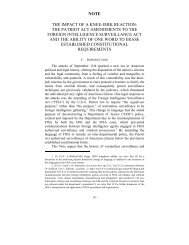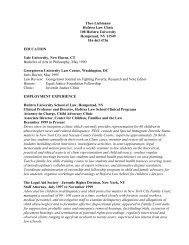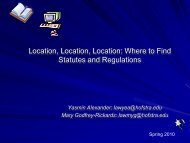JOURNAL OF INTERNATIONAL BUSINESS & LAW - Hofstra Law ...
JOURNAL OF INTERNATIONAL BUSINESS & LAW - Hofstra Law ...
JOURNAL OF INTERNATIONAL BUSINESS & LAW - Hofstra Law ...
You also want an ePaper? Increase the reach of your titles
YUMPU automatically turns print PDFs into web optimized ePapers that Google loves.
ARBITRATION FORMATTED4/24/2009 5:11:49 PM<strong>INTERNATIONAL</strong> COMMERCIAL ARBITRATIONunderscored that it is the second, i.e., a challenge to the contract as a whole andnot specifically to the arbitration clause, that brings before it the issueconcerning whether court or arbitrator should adjudicate the validity of thecontract. 83 Four critical premises were analyzed in highlighting the primacy of thearbitral process, the precept of party-autonomy, and the new role of judicialintervention in arbitral proceedings. First, the Florida Supreme Court hadplaced considerable weight on the distinction arising between “void” and“voidable” contracts. Indeed, it asserted that “Florida public policy and contractlaw,” permit “no severable, or salvageable, parts of a contract found illegal andvoid under Florida <strong>Law</strong>.” 84 The Court rejected this proposition based upon itsunderstanding of Prima Paint. Specifically, the Supreme Court observed how“[t]hat case rejected application of state severability rules to the arbitrationagreement without discussing whether the challenge at issue would haverendered the contract void or voidable.” 85 In addition, further analytic supportwas drawn from Southland where the Court deliberately and explicitly rejectednot to consider whether the legal and factual averments in the underlyingcomplaint rendered the contract at issue either void or voidable. 86 Instead, itdisavowed the assertion that the enforceability of an arbitration agreement iscontingent upon a state legislature’s determination of the applicable forum forenforcement of a state law statutory cause of action. 87 Likewise, the Court heldthat it “cannot accept the Florida Supreme Court’s conclusion thatenforceability of the arbitration agreement should turn on ‘Florida public policyand contract law.’” 88Second, the FAA’s “substantive” command in Section 2 wasemphasized in the context of the Court’s prior ruling in Prima Paint. Notsurprisingly, respondents had argued that Prima Paint’s stricture was predicatedonly on Sections 3 and 4 of the FAA’s “procedural” provisions. 89 Respondentsfurther asserted that both these sections exclusively applied to the FederalCourt, while Section 2 is the only provision that the Supreme Court had appliedsigned the contract.Id. at 444 n.1.83 See id.84 Cardegna, 894 So.2d at 864.85 Buckeye Check Cashing, Inc. v. Cardegna, 546 U.S. 440, 446 (2006) (citing Prima Paint Corp. v.Flood & Conklin Mfg. Co., 388, U.S. 395, 400-404 (1967)).86 Id. at 447-48.87 Id. at 446.88 Id. (citing Cardegna, 894 So.2d at 864).89 Id. at 447.85


